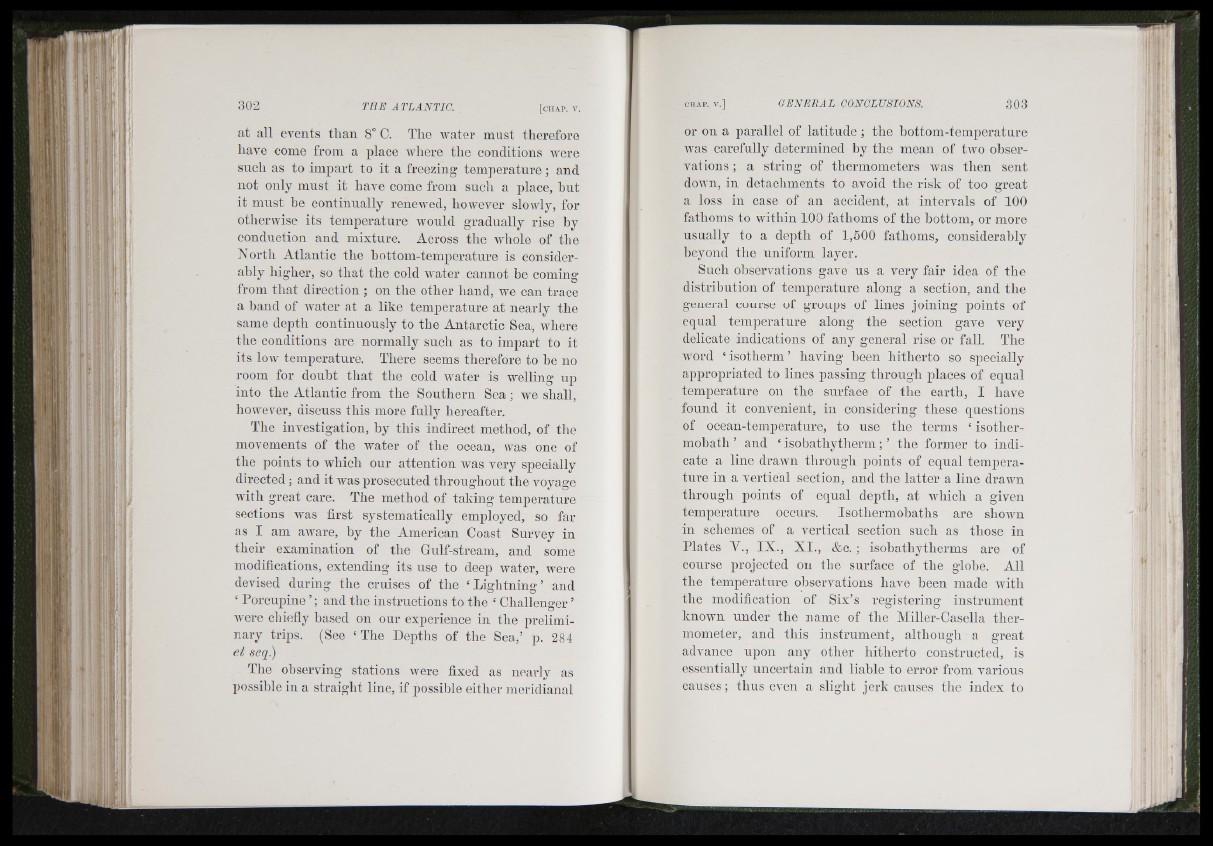
EMti
t F i
at all events tlian 8° C. The Avater must therefore
have come from a place Avliere the conditions Avere
snch as to impart to it a freezing tem p e ra tn re ; and
not only mnst it have come from sn d i a place, hnt
it mnst be continnally reneAved, however slowly, for
otherwise its temperatnre Avonld gradually rise by
conduction and mixture. Across tbe Avbole of tbe
North Atlantic tlie bottom-temperatnre is considerably
bigber, so tb a t the cold w'ater cannot be coming
from th a t direction ; on tbe other band, Ave can trace
a band of Avater at a like temperature at nearly tbe
same depth continuously to tbe Antarctic Sea, Avbere
tbe conditions are normally sncb as to impart to it
its loAv temperature. Tbere seems therefore to be no
room for doubt tb a t tbe cold Avater is welling up
into tbe Atlantic from tbe Sontbern S e a ; Ave shall,
lioweA'er, discuss tbis more fully hereafter.
The investigation, by tbis indirect method, of the
movements of the Avater of tbe ocean, vA'as one of
tbe points to Avhich our attention was very specially
directed ; and it was prosecuted throughout the voyage
Avitli great care. The method of taking temperatnre
sections Avas first systematically employed, so far
as I am aAvare, by tbe American Coast Survey in
their examination of tbe Gnlf-stream, and some
modifications, extending its use to deep Avater, Avere
devised during tbe cruises of tbe ‘ Lightning ’ and
‘ Porcupine ’; and the instructions to tbe ‘ Challenger ’
Avere cliiefly based on our experience in tbe preliminary
trips. (See ‘ The Depths of tbe Sea,’ p. 284
et seq.)
Tbe observing stations Avere fixed as nearly as
possible in a straight line, if possible either meridianal
or on a parallel of latitude ; the bottom-temperatnre
Avas carefully determined by the mean of two observations
; a string of thermometers Avas then sent
down, in detachments to avoid the risk of too great
a loss in case of an accident, at intervals of 100
fathoms to AA'ithin 100 fathoms of the bottom, or more
usually to a depth of 1,500 fathoms, considerably
beyond tbe uniform layer.
Snch observations gave us a A'ery fair idea of tbe
distribution of temperatnre along a section, and tbe
general course of groups of lines joining points of
equal temperature along tbe section gave very
delicate indications of any general rise or fall. The
word ‘ isotherm ’ having been hitherto so specially
appropriated to lines passing tlirougli places of equal
temperature on tbe surface of tbe earth, I have
fonnd it convenient, iu considering these questions
of ocean-teniperature, to use the terms ‘ isothermobath
’ and ‘ isobathytherm ; ’ the former to indicate
a line drawn through points of equal temperature
in a vertical section, and the latter a line drawn
through points of equal depth, at Avhich a given
temperature occurs. Isothermohaths are shoAvn
in schemes of a vertical section such as those in
Plates V., IX., XI., &c. ; isohathytherms are of
course projected on tbe surface of tbe globe. All
tbe temperature observations have been made Avith
the modification of Six’s registering instrument
knoAvn under tbe name of tlie Miller-Casella th e rmometer,
and tbis instrument, altbougb a great
advance upon any other hitherto constructed, is
essentially uncertain and liable to error from various
causes ; thus even a slight jerk causes tbe index to
''"i
''tv ■ u
"4